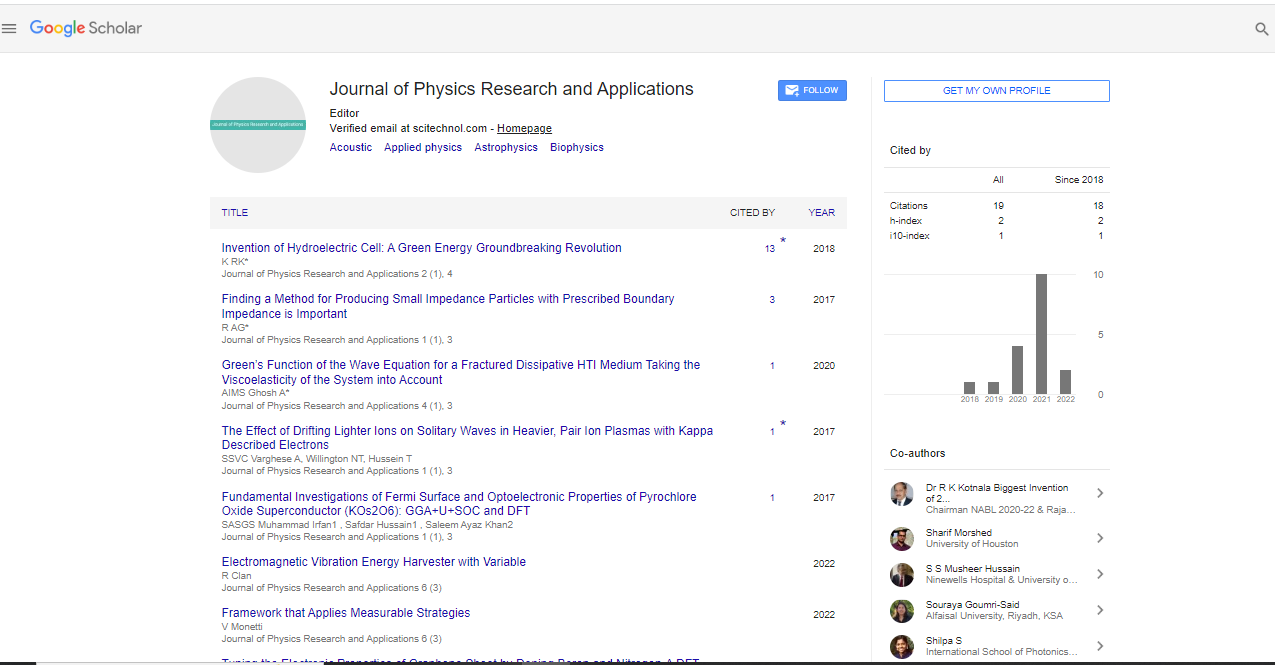Short Communication, J Phys Res Appl Vol: 8 Issue: 3
Charge Density Waves and their Role in Exotic Material Properties
Jeong chi*
1Department of Physics, Southeast University, Nanjing, China
*Corresponding Author:: Jeong chi,
Department of Physics, Southeast University, Nanjing, China
E-mail: jeo@1353567.cn
Received: 26 August, 2024, Manuscript No. JPRA-24-151991;
Editor assigned: 28 August, 2024, PreQC No. JPRA-24-151991 (PQ);
Reviewed: 11 September, 2024, QC No. JPRA-24-151991;
Revised: 18 September, 2024, Manuscript No. JPRA-24-151991 (R);
Published: 25 September, 2024, DOI: 10.4172/JPRA.1000115.
Citation: Chi J (2024) Charge Density Waves and their Role in Exotic Material Properties. J Phys Res Appl 8:3.
Description
In condensed matter physics, the concept of Charge Density Waves (CDWs) has emerged as an important phenomenon that offers deep insights into the behavior of electrons in materials. CDWs, essentially periodic modulations of the electron density within a material, are characterized by a wave-like structure in which electrons align in a specific, repeating pattern. This behavior, commonly observed in lowdimensional materials and compounds with quasi-one-dimensional electronic structures, leads to fascinating electronic, magnetic, and optical properties that are termed "exotic" due to their deviation from conventional material behaviors. Charge density waves are formed when electrons in a material interact in such a way that their density undergoes a periodic modulation. This modulation is typically driven by the coupling between the electrons and the crystal lattice in a phenomenon known as electron-phonon coupling. In simpler terms, the CDW formation can be thought of as a structural rearrangement within the material, where both the electronic density and the positions of the atoms adjust to achieve a lower energy configuration. This new arrangement can be visualized as a standing wave pattern of electron density, where high and low electron density regions alternate periodically [1].
One of the key factors influencing CDW formation is the fermi surface, which represents the collection of quantum states occupied by electrons at the highest energy levels within a material. In certain lowdimensional materials, the geometry of the fermi surface supports a nesting effect, where large portions of the fermi surface can be shifted and mapped onto other parts. The energy reduction achieved through CDW formation results in an energy gap near the fermi level, similar to what occurs in superconductors, and imparts unique electronic properties to the material. The existence of CDWs in a material leads to a range of exotic properties, some of which are reminiscent of those observed in superconductors and magnets. For example, CDW materials exhibit electronic and optical properties that can be tuned by manipulating the wave vector, amplitude and phase of the CDW [2-4].
The main properties of CDW systems are the metal-insulator transition, where a material that conducts electricity under certain conditions becomes an insulator when the CDW is fully developed. This transition occurs as a result of the opening of an energy gap at the fermi surface due to the formation of the CDW. As the temperature is lowered, the CDW order strengthens, further reducing the conductivity of the material. This phenomenon is highly temperature-dependent and can be used to design materials with tunable conductive properties. CDW materials also exhibit nonlinear conductivity, which means their resistance changes in response to applied voltage in a way that is not directly proportional. In particular, when a sufficiently large electric field is applied, the CDW can depin and begin to slide, leading to a sudden increase in conductivity [5-7].
In CDW systems, electrons are organized into a coherent, wave-like state, which results in collective excitations, known as phases that propagate through the material. These phasons can be thought of as ripples in the CDW structure and exhibit behavior that differs from the individual particle excitations in traditional conductors. Phasons contribute to the unique transport properties of CDW materials and influence how they respond to external fields and thermal fluctuations. CDW materials can exhibit thermally activated behavior, where the transition between insulating and conductive states is triggered by changes in temperature. In addition, some CDW systems demonstrate memory effects, where the material "remembers" previous states based on its thermal or electrical history. This memory property, coupled with tunable resistance, has drawn significant interest in the field of electronic data storage, as CDW materials could be used to create devices capable of retaining information without a continuous power supply [8].
The unique properties of CDW materials have motivated research into potential applications in electronics and quantum computing. Their tunable conductivity, temperature-sensitive phase transitions, and nonlinear response make them attractive for designing nanoscale switches and memory devices. The ability of CDW systems to undergo metal-insulator transitions in response to changes in temperature or electric fields could also be used in sensors and transistors. In recent years, the study of CDWs has expanded to explore their role in topological materials, where they may co-exist or interact with other quantum phases, such as super conductivity [9,10].
References
- Gruner G (1988) The dynamics of charge-density waves. Rev Mod Phys 60(4):1129.
- Zhu X, Cao Y, Zhang J, Plummer EW, Guo J (2015) Classification of charge density waves based on their nature. Proc Natl Acad Sci 112(8):2367-2371.
[Crossref]
- Gorkov LP, Gruner G. Charge density waves in solids. Elsevier.
- Rossnagel K (2011) On the origin of charge-density waves in select layered transition-metal dichalcogenides. J Condens Matter Phys 23(21):213001. [Crossref]
- Zhu X, Guo J, Zhang J, Plummer EW (2017) Misconceptions associated with the origin of charge density waves. Adv Phys 2(3):622-640.
- Chen CW, Choe J, Morosan E (2016) Charge density waves in strongly correlated electron system. Rep Prog Phys 79(8):084505.
- Littlewood PB (1986) Sliding charge-density waves: A numerical study. Phys Rev 33(10):6694.
- Lee PA, Rice TM (2018) Electric Field Depinning of Charge Density Waves. CRC press.
- Fisher DS (1975) Sliding charge-density waves as a dynamic critical phenomenon. Phys Rev 31(3):1396.
- Overhauser AW (1971) Observability of charge-density waves by neutron diffraction. Physi Rev 3(10):3173.
 Spanish
Spanish  Chinese
Chinese  Russian
Russian  German
German  French
French  Japanese
Japanese  Portuguese
Portuguese  Hindi
Hindi 
